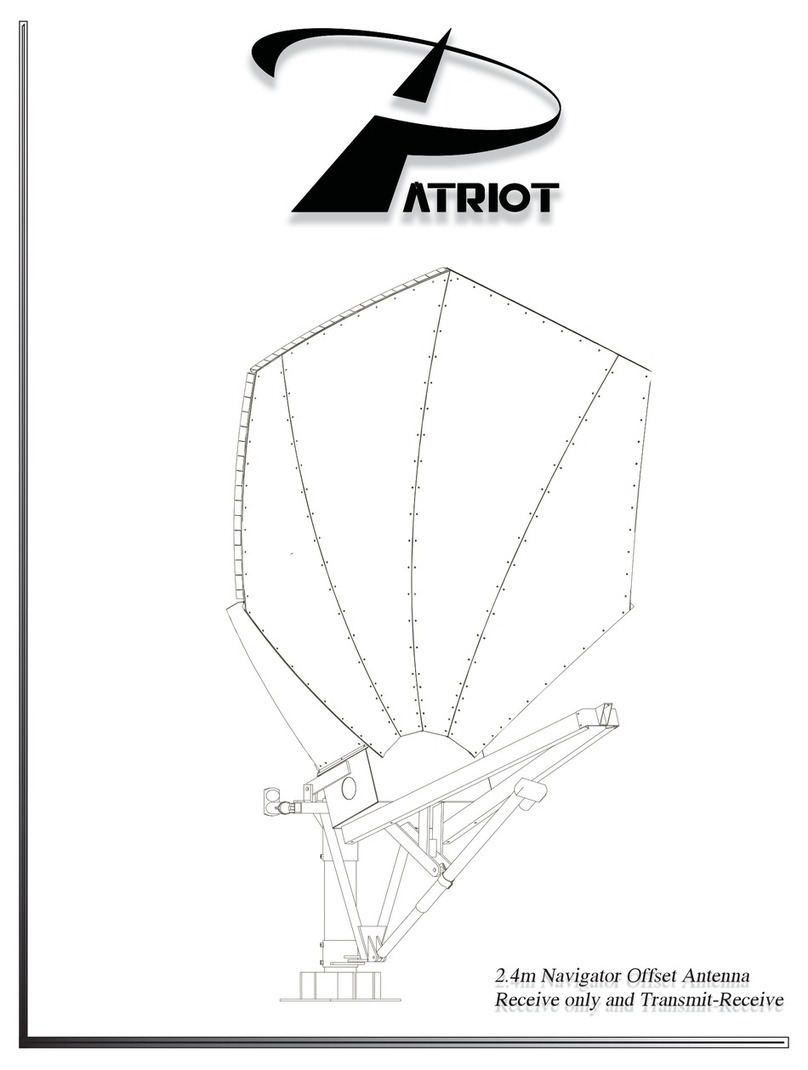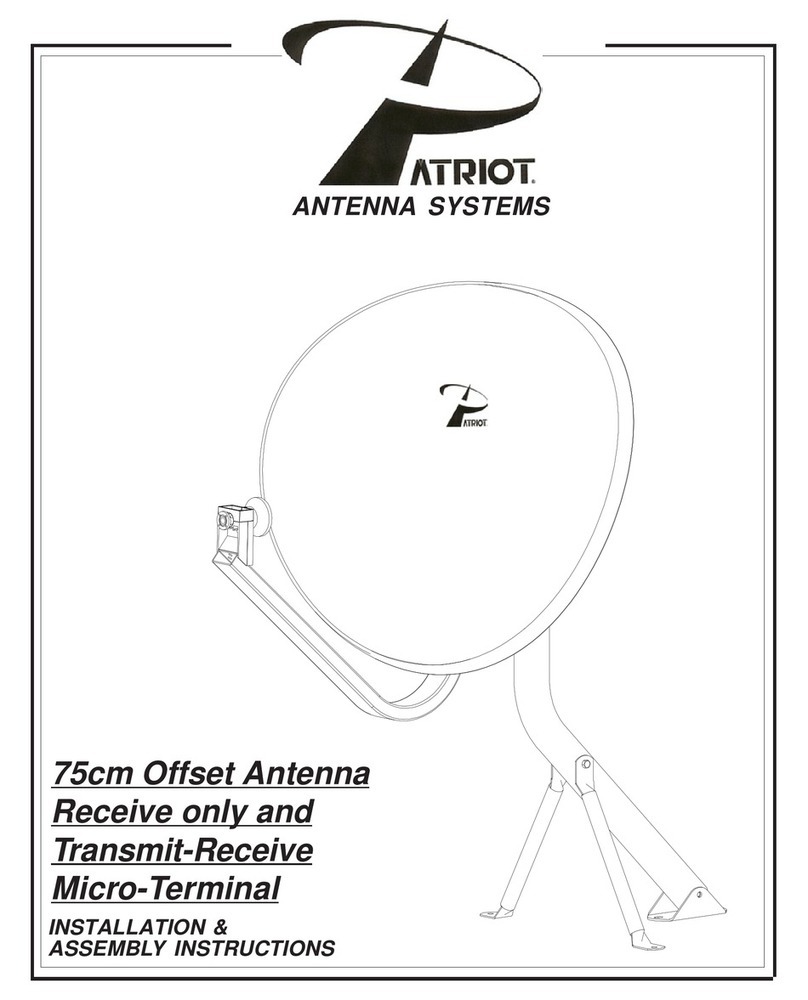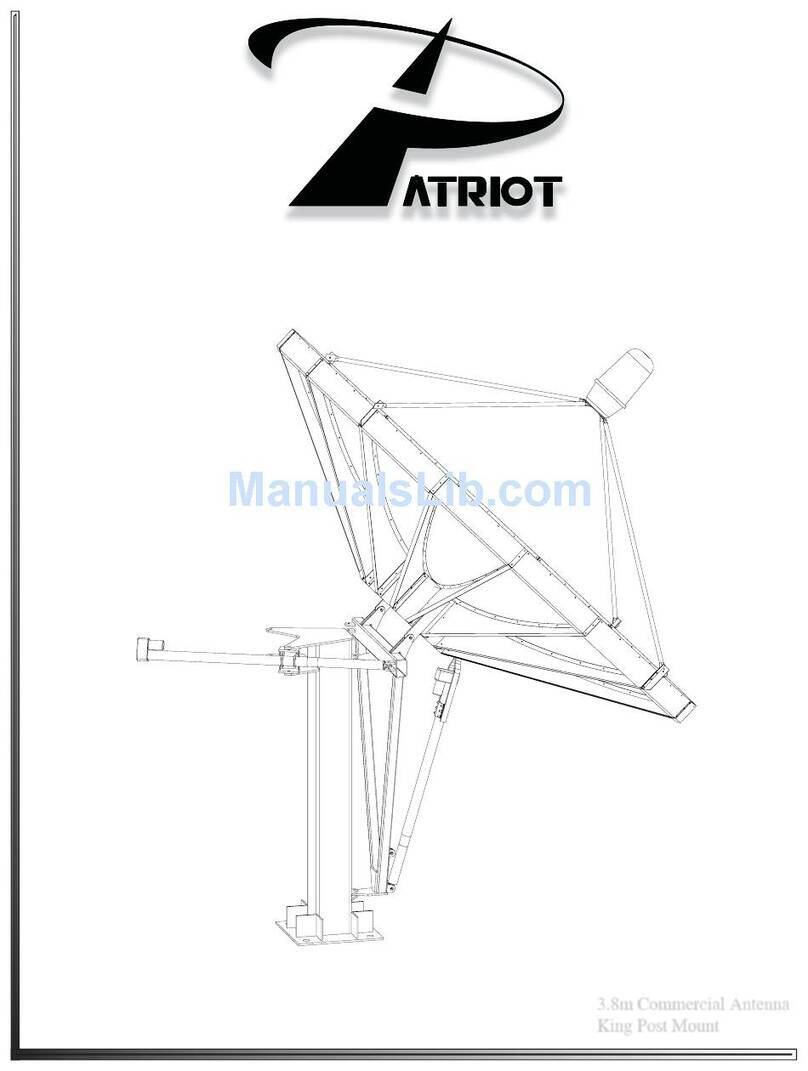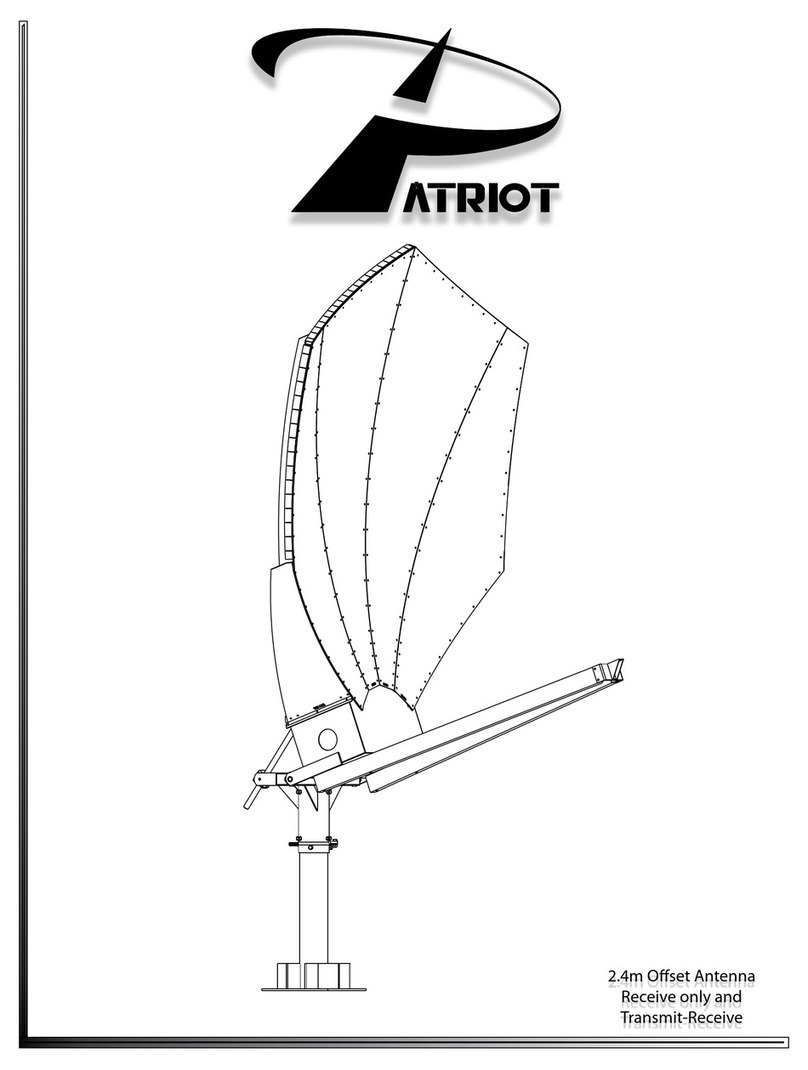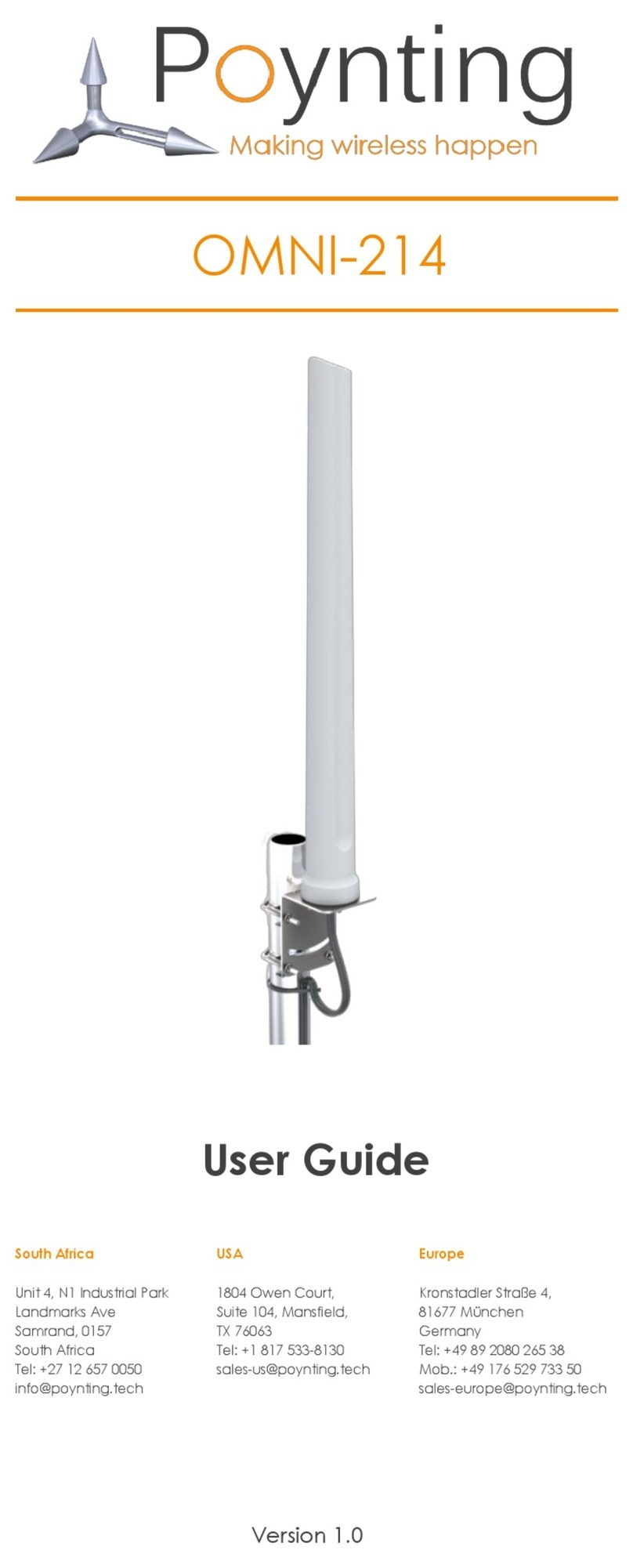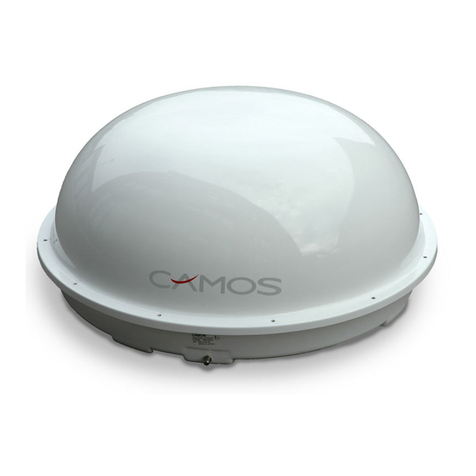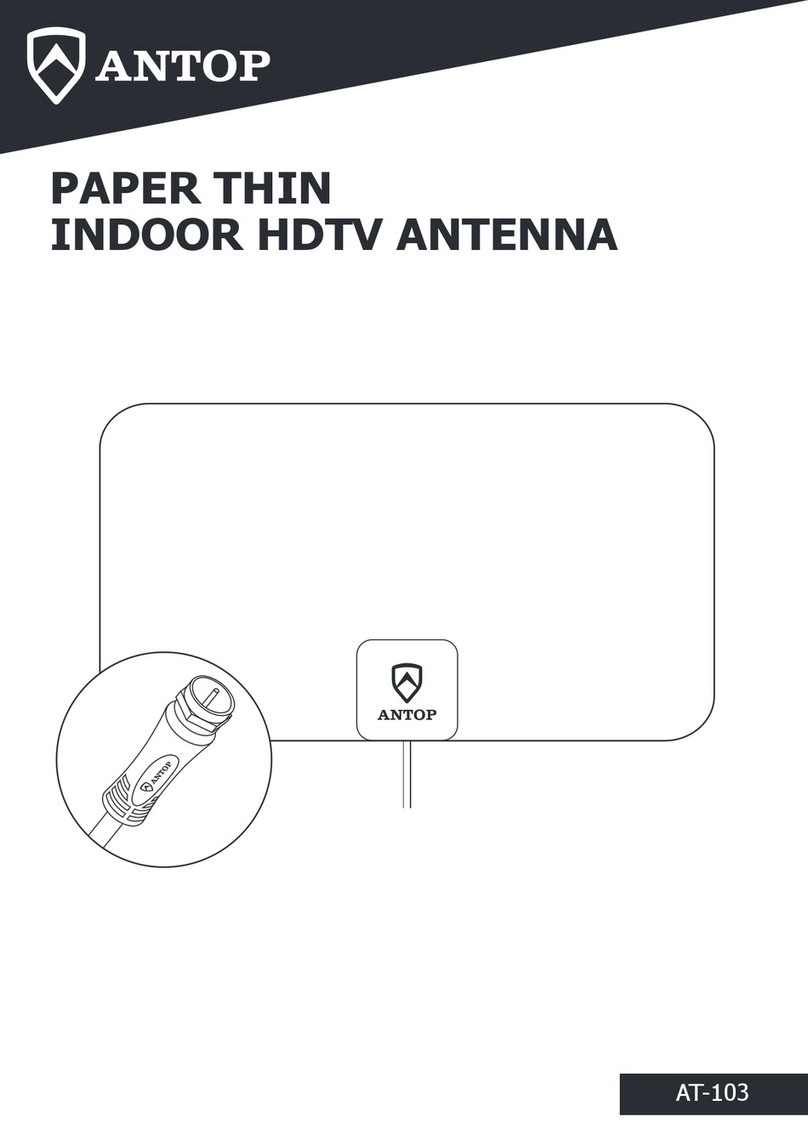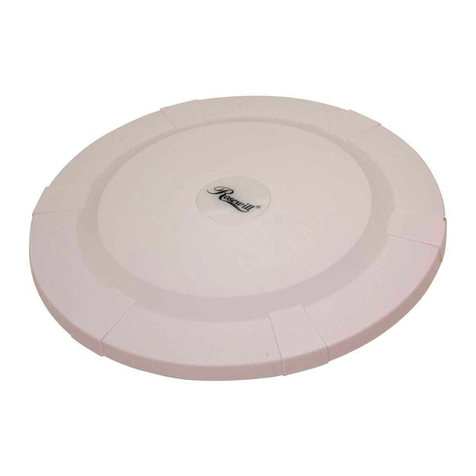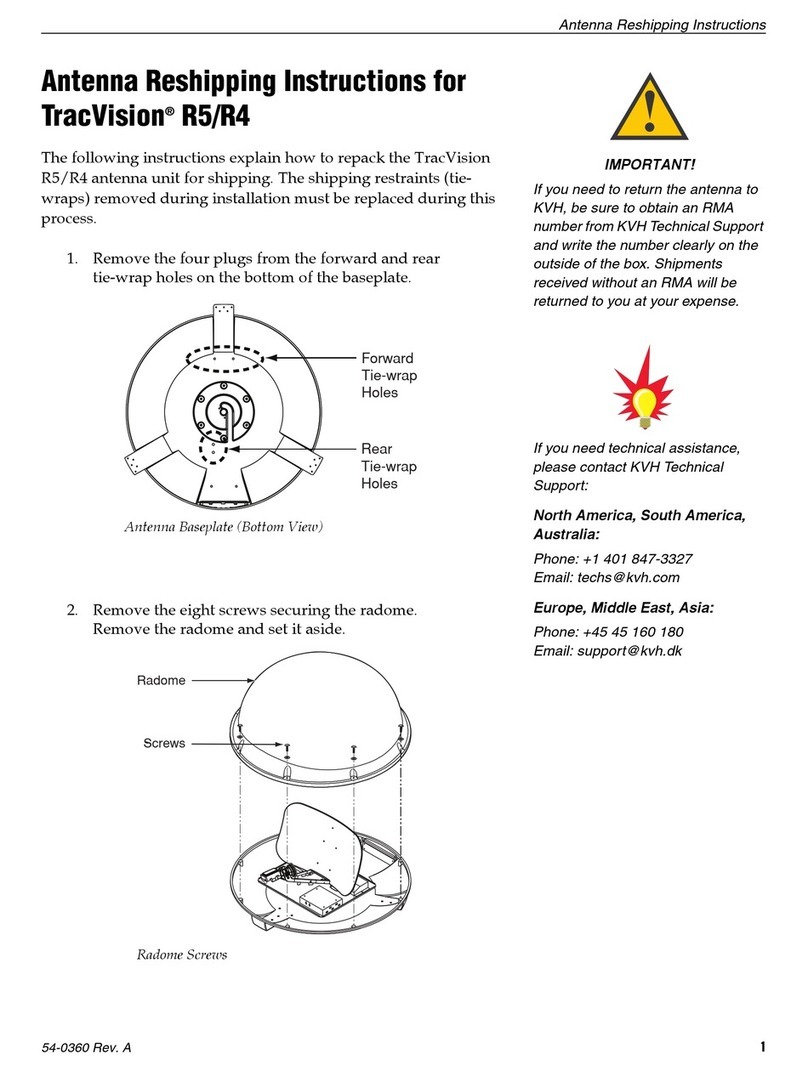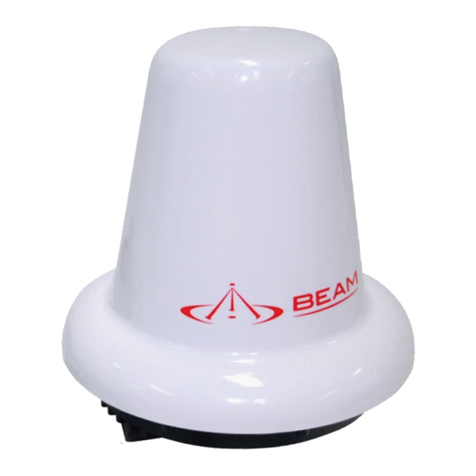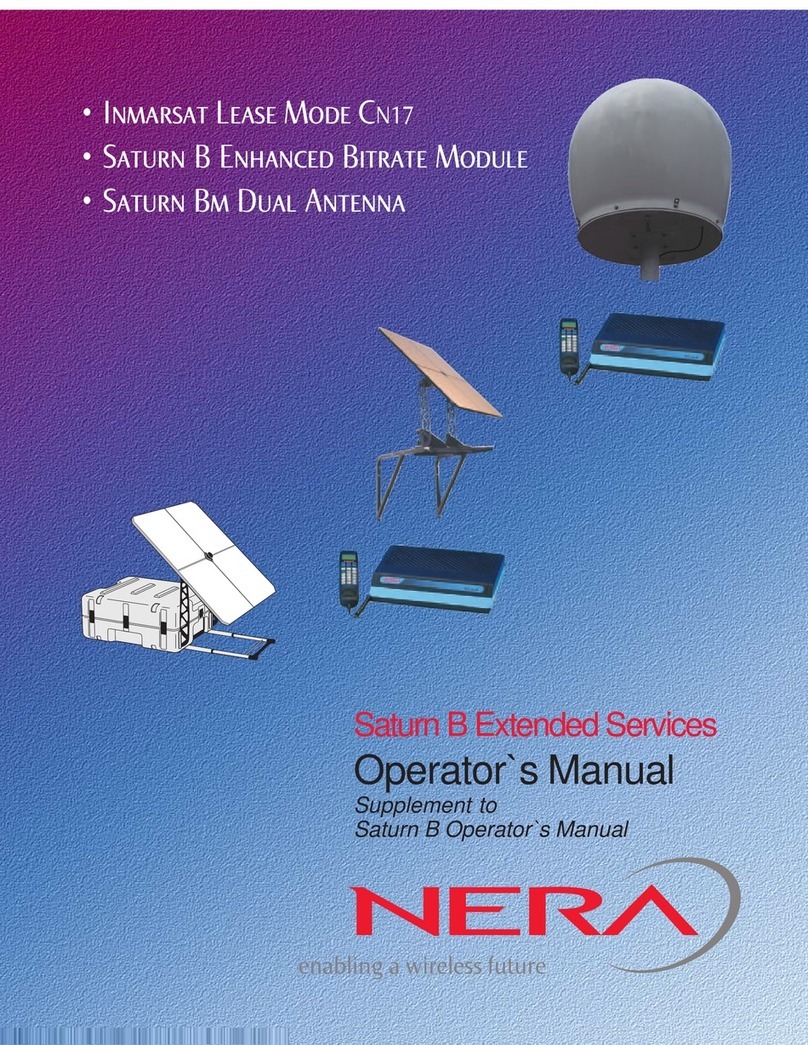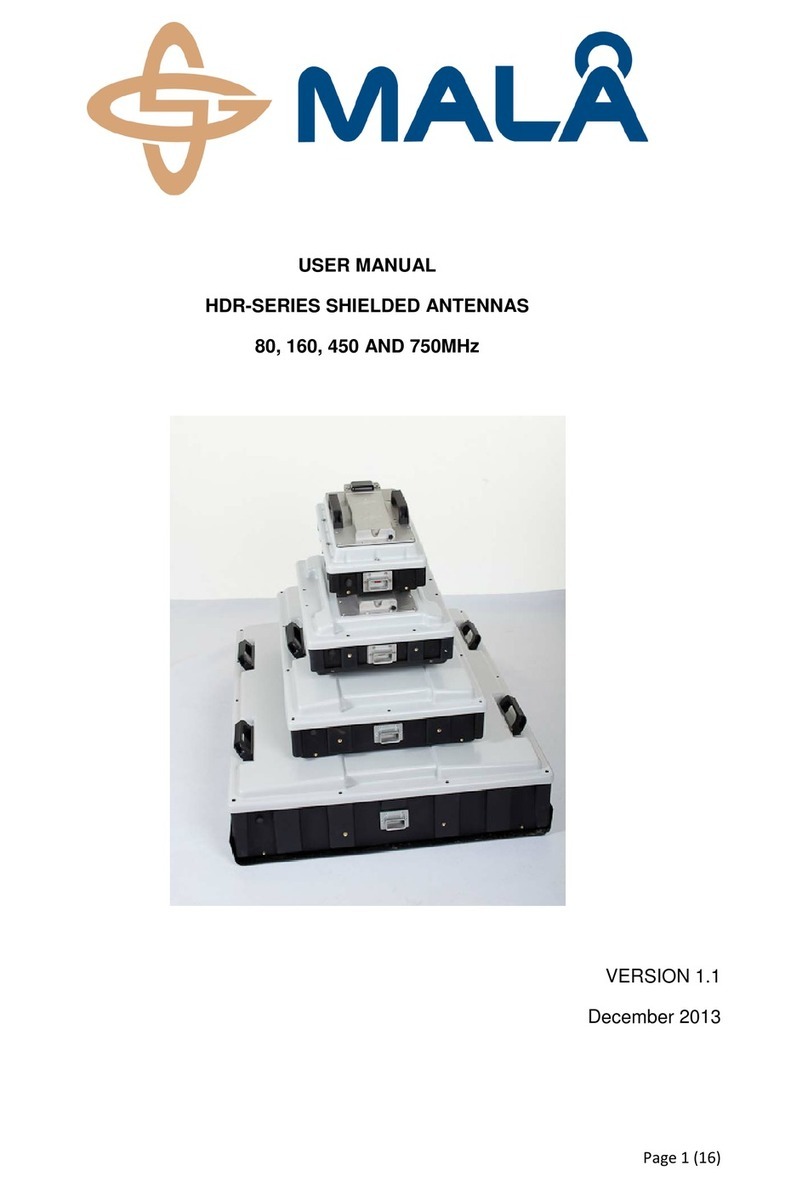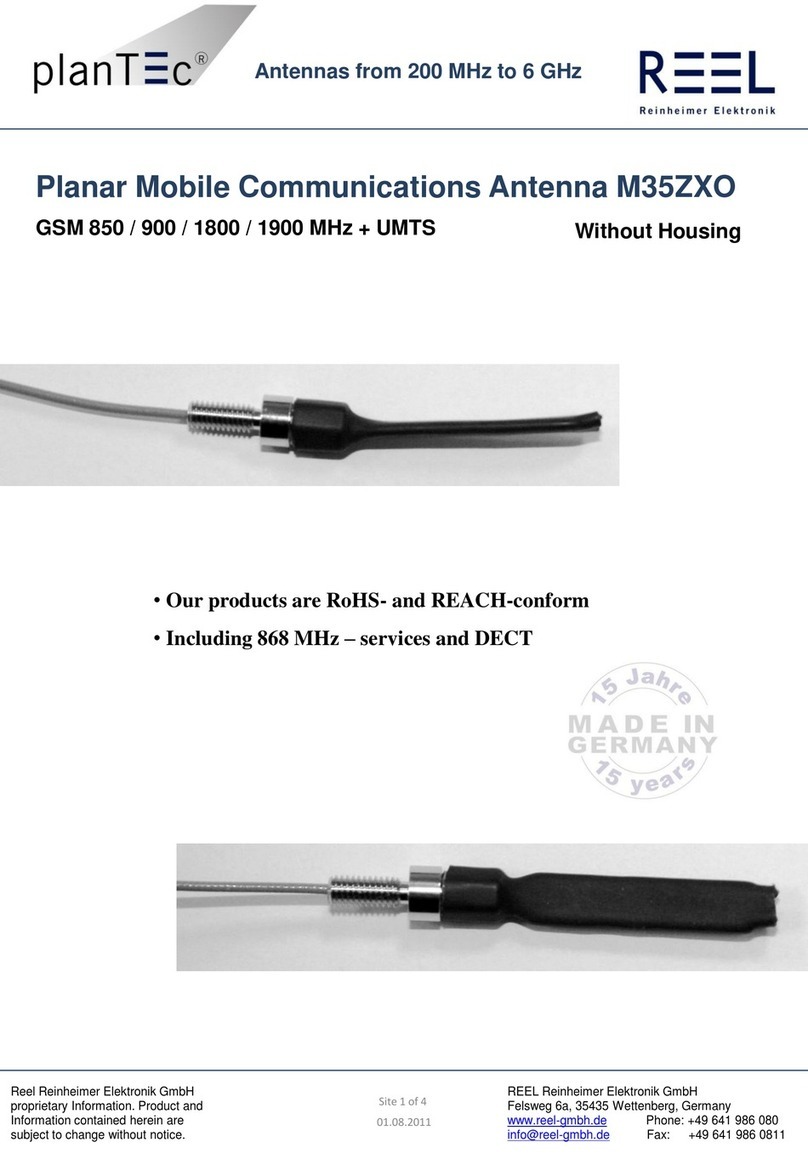Patriot Commercial Antenna Polar Mount User manual

3.1m Commercial Antenna
Polar Mount

2
This PATRIOT ANTENNA equipment is warranted to be free from defects in material and workmanship un-
der normal use and service. PATRIOT ANTENNA shall repair or replace defective equipment, at no charge,
or at its option, refund the purchase price, if the equipment is returned to PATRIOT ANTENNA not more than
twelve (12) months after shipment. Removal or reinstallation of equipment and its transportation shall not be
at cost of PATRIOT ANTENNA except PATRIOT ANTENNA shall return repaired or replaced equipment
freight prepaid.
This Warranty shall not apply to equipment which has been repaired or altered in any way so as to affect
its stability or durability, or which has been subject to misuse, negligence or accident. This Warranty does
not cover equipment which has been impaired by severe weather conditions such as excessive wind, ice,
storms, lightning, or other natural occurrences over which PATRIOT ANTENNA has no control, and this War-
ranty shall not apply to equipment which has been operated or installed other than in accordance with the
instructions furnished by PATRIOT ANTENNA.
Claimants under this Warranty shall present their claims along with the defective equipment to PATRIOT
ANTENNA immediately upon failure. Noncompliance with any part of this claim procedure may invalidate
this warranty in whole or in part.
THIS WARRANTY IS EXPRESSLY IN LIEU OF ALL OTHER AGREEMENTS AND WARRANTIES, ANY
IMPLIED WARRANTY OF MERCHANTABILITY OR FITNESS FOR A PARTICULAR PURPOSE IS LIMITED
IN DURATION TO THE DURATION OF THIS WARRANTY. PATRIOT ANTENNA DOES NOT AUTHORIZE
ANY PERSON TO ASSUME FOR IT THE OBLIGATIONS CONTAINED IN THIS WARRANTY AND PATRI-
OT ANTENNA NEITHER ASSUMES NOR AUTHORIZES ANY REPRESENTATIVE OR OTHER PERSON
TO ASSUME FOR IT ANY OTHER LIABILITY IN CONNECTION WITH THE EQUIPMENT DELIVERED OR
PROVIDED.
IN NO EVENT SHALL PATRIOT ANTENNA BE LIABLE FOR ANY LOSS OF PROFITS, LOSS OF USE, IN-
TERRUPTION OF BUSINESS, OR INDIRECT, SPECIAL OR CONSEQUENTIAL DAMAGES OF ANY KIND.
In no event shall PATRIOT ANTENNA be liable for damages in an amount greater than the purchase price
of the equipment.
Some states do not allow limitations on how long an implied warranty lasts, or allow the exclusion or limita-
tion of incidental or consequential damages, so the above limitations or exclusions may not apply to you.
PATRIOT ANTENNA has the right to void the warranty when the antenna is installed by someone other then
a certified installer.
LIMITED TWELVE (12) MONTH WARRANTY
Product Serial Number- _________________
Date Purchased- ____________
Patriot Antenna Systems
704 North Clark Street
Albion, MI 49224 USA
Tel: (517)629-5990
Fax: (517)629-6690

3
.
1. Perform as many functions as possible on the ground.
2. Watch out for overhead power lines. Check the distance to the power lines before starting installation.
We recommend you stay a minimum of 6 meters (20 feet) from all power lines.
3. Do not use metal ladders.
4. Do not install antenna or mast assembly on a windy day.
5. If you start to drop antenna or mast assembly, get away from it and let if fall.
6. If any part of the antenna or mast assembly comes in contact with a power line, call your
local power company. DO NOT TRY TO REMOVE IT YOURSELF! They will remove it safely.
7. Make sure that the mast assembly is properly grounded.
WARNING
Assembling dish antennas on windy days can be dangerous. Because of the antenna surface, even slight
winds create strong forces. For example, a 1.0m antenna facing a wind of 32 km/h (20 mph) can undergo
forces of 269 N (60 lbs.). Be prepared to safely handle these forces at unexpected moments. Do not at-
tempt to assemble, move or mount dish on windy days or serious, even fatal accidents may occur. PA-
TRIOT ANTENNA SYSTEMS is not responsible or liable for damage or injury resulting from antenna
installations.
WARNING
Antennas improperly installed or installed to an inadequate structure are very susceptible to wind damage.
This damage can be very serious or even life threatening. The owner and installer assumes full responsibil-
ity that the installation is structurally sound to support all loads (weight, wind & ice) and properly sealed
against leaks. PATRIOT ANTENNA SYSTEMS will not accept liability for any damage caused by a
satellite system due to the many unknown variable applications.
INSTALLATION OF THIS PRODUCT SHOULD BE PERFORMED ONLY BY A PROFESSIONAL
INSTALLER AND IS NOT RECOMMENDED FOR CONSUMER D.I.Y. (DO-IT-YOURSELF)
INSTALLATIONS.
IMPORTANT!!!
WATCH FOR WIRES!
Installation of this product near power lines is dangerous. For your own safety,
follow these important safety rules.

4
Unpacking and Inspection
Shipping cartons should be unpacked and contents checked for damaged or missing parts. Should there be any parts that
are damaged or missing, please contact technical support for replacement.
Site Selection
The main objective of conducting a site survey utilizing a compass and inclinometer is to choose a mounting location on the
ground that will give you the greatest amount of swing for azimuth and elevation for present as well as future use. A thorough
pre-installation site survey is strongly recommended because it can alert you to any “look angle”, soil, wind or other
problems.
The first and most important consideration when choosing a prospective antenna site is whether or not the area can provide
an acceptable “look angle” to the satellite. A site with a clear, unobstructed view facing south, southeast is required. Your
antenna site must be selected in advance so that you will be able to receive the strongest signal available. Also consider
obstructions that may occur in the future such as the growth of trees.
It is important to conduct an on-site survey with a portable antenna or with a compass and clinometer to avoid interference,
obstructions, etc.
When selecting “look angle”, be sure to observe and take readings approximately 10 deg to the left and right, above and
below your selected “look angle”.
Before Ground Pole Installation, the soil type should be checked because soil conditions vary widely in composition and
load bearing capacity. A soil check will help you to determine the type
and size of foundation required to provide a stable base for the antenna.
Before digging is done, information regarding the possibility of underground telephone lines, power lines, storm drains, etc.,
in the excavation area should be obtained from the appropriate agency.
As with any other type of construction, a local building permit may be required before installing an antenna. It is the property
owner’s responsibility to obtain any and all permits. Ground mounts are certified for 125 mph wind survival.
Introduction
Thank you for purching your Patriot Commercial Antenna. We trust that you will find this to be a well
designed product that will proved many years of reliable service. Please read this manual thoroughly before
beginning assembly. For best results in the assembly process, perform each step in the same sequence as
listed in this manual. Record the serial munber of the unit on to page two for future refferance and read the
warrenty information. The serial number plate can be found on the pedestal mount.

5
ITEM # PART# DESCRIPITION REV QTY
1 231001 PETAL, 3.1 PRIME 000 8
2 231002 RADIAL BEAM, 3.1 PRIME WELDED 000 8
3 231003 OUTBOARD SKIRT, 3.1 PRIME 000 8
4 231004 ASSY, 3.1 HUB 000 1
5 231106 PLATE, C-BAND 3.1/3.8/4.5 000 1
6 PRT-POLAR MOUNT, POLAR 3.1mtr 000 1
7 231081 BRKT, TRACKER EXTENTION 000 2
8 231009 STRUT, 3.1 PRT FEED 000 4
See Pg 8 231082 ASSY,POLAR TRACKER ATTMT 000 1
6
7
8
1
5
32
4

6
60"
24"
40"
1/2"
4"
3"
3"
40"
14" 18" 40"
14"
18"
4.0” O.D.
Steel Pipe
#4 Rebar in all concrete
pad surfaces
Base Plate
18”x18”x1/2” 4 Typ 1 1/4”
Diam.x24”
BOLT AND TEMPLATE KIT (PT# PRT-BTKPS)
(1) Cardboard template. (to be removed after cement sets)
(4) KP/PIPE MT Foundation Template Straps
(4) 1-1/4x24” Threaded Rod (Bolts)
(8) 1-1/4” Nuts & Washers
Bolt and Template Kit with Pipe (On one skid) = 215 Lbs.
Note: See Foundation Requirements & Specifications above.
In-Ground Mast Foundation
Foundation Requirements & Specifications:
• Steel Mast: Schedule 80, L=120”; 4” O.D.
• Concrete: 3000 psi at 28 days, poured against undistrurbed
soil
(Allow concrete 24 hour set time before installation of
antenna)
• Soil Bearing Capacity > 2000 psf.
• Ground the Antenna to meet applicable local Codes.
60in
min.
48in
60in
5-1/2 OD Pipe
24in OD
Anti-Twist
Weldment
Grade level
Optional Mast Pipe (Prt# PRT-PST400)
with Bolt & Template Kit
4 Anchor Bolts
1 1/4” Diam.
60

7
Rough
Adjustment bolt
231081
BRKT, TRACKER
EXTENTION
*
* Pre-assembled hardware NOT shown for
ease of illistration in these areas.
*
*
1) Attach Tracker Extention Brackets to Polat Mount as pictured below. (Mkae sure to stack
BOTH brackets to ensure proper allignment of azimuth lock down)
2) Loosen all Rough Adjustment bolts and set Polar Mount to “birds bath” (straight up) position
3) Tighten all Rough Adjustment bolts.
Mount Prep.

8
1. Lay the hub face down and place the preassembled Polar Mount on top of the hub placing two bolts each
in top and bottom clevises. Tighten these bolts.
2. With a helper lift the Hub/Mount assembly and slide it down onto the 4” mast pipe.
3. Attach 231082 ASSY,POLAR TRACKER ATTMT to the proper side of the hub where the
majority of the satellites to be viewed are located.
4. Adjust POLAR MOUNT so that hub is pointing straight up. Sung rouch adjustment bolts at this time.
231082
ASSY,POLAR
TRACKER ATTMT
231004
ASSY, 3.1 HUB
Bottom
Clevis
Top
Clevis
Hub Assembly

9
Reflector Assembly
5. Pre-install 9- J-Clips and into each
of the 8 Radial Beams as shown.
6. Install the 8 Radial Beams to the Hub using hard-
ware labeled- Radial Beam pack as shown.
J-clips
7. Now install the Outboard Skirts on the end
of the Radial Beams as shown using 2-1/4”
Allen bolts from hardware labeled Reflector
and Feed pack (note the overlay of the
adjacent skirt). Leave this hardware loose.
If not installed already, install the 8 threade
d
rubber grommets and hub plug to the front
side of the hub at this time.

10
8. Install Anenna Panels noting overlay of joining edge. Join 2 panels to one Radial Beam
using 1/4” Allen Bolts from the Reflector and Feed pack. Work out from the hub (note edge
overlay should be even) Tighten the hardware into each J-clip after all hardware is in place.
9. Install 48- 1/4” Allen bolts with flange nuts to Antenna Panel perimeter edge and Outboard
Skirts tightening them as they are installed.
10.Tighten all Reflector hardware at this time.

11
Reflector and Feed Support Assembly
11. Feed Struts are to be
installed as shown by using
the fourth bolt from the edge
of the reflector . Install the 4
struts 90 degrees apart using
every other panel.
Feed
Struts
4th Hole

12
12. Assemble the Feed Plate to the inside of the Feed Struts as
shown using the 1/4” hardware also from the Feed Strut Top pack.
Then assemble the feed scalar to the dish side of the plate using the
4 slotted holes with the feed cover bottom half to the opposite side
of the plate.
NOTE: The 4 slotted holes provide skew adjustment setting
13. Check Focal Distance- 1.04m (41.04”)
Feed Cover
C-Band
Feed
Plate
(Optional 3.1m Wind Kit)
Install the Wind Kit Struts to the back of the Reflector using the supplied 1/4” hard-
ware as shown below.
2. Install the Wind Kit Struts to the back of the
Reflector using the supplied 1/4” hardware as shown
below.
Place inside of
Outboard Skirt
1. If you received a unit without a pre-drilled hub
assembly, the needed holes will need to be drilled
with a hand drill. Using a 5/16” drill, drill the 8 holes
needed along the back rim of the hub. The holes
should be equally spaced between the Radial Beam
holes, and aligned in the same bolt circle.

13
1.) Start with checking the mounting of the feed horn. All the legs on the tripod should be of the same length. You should
measure them, and do any adjustment you can if they are not the same length. Next you have to check the distance
from three different points on the edge of the dish, to the center of the feed horn. Remember, even if the tripod legs have
the same length, that does not mean the feed is centered! You might have to “bend” the feed back into center of the
dish.
2.) Set the off-set angle on your polar mount (declination). This is an adjustment that tilts the dish forward at an angle
of about 4-6 degrees, depending on what latitude you live. You can find the exact angle for your location in charts, but
if you set it for about 5 degrees, you’ll be close enough to get going. This adjustment is usually done on one of the
mounts connected directly to the dish.
3.) You then move the dish to the highest point on your polar mount. You do this by using the actuator. You can do this
by visually looking at the dish and the polar mount. You are basically centering the dish on the highest point on the polar
mount. Now you have to set the elevation angle of the dish. I like to use a meter for this, but it is also possible to do it
without. The elevation angle is about 40 degrees, depending on you latitude. This is not very critical at this point
because you will adjust the angle for best reception later. If you measure the angle on the mount, you might have to add
the declination angle to get the true dish pointing angle.
4.) You need to find a satellite that is located just south of your location. In most cases, there is a satellite close to the
longitude you live. A few degrees off will not make much difference because the dish moves almost flat in the center
of arc. Try a Ku band satellite because the accuracy is much higher. However, you night look for a C band satellite
when you start. It will be easier to find than a Ku band satellite. Having the dish parked at the highest point of the arc,
you have to turn the whole polar mount on the ground pole till you hit the satellite. If your elevation was way off, you
might not even get a signal. Adjust the elevation and turn the mount again until you find the satellite located straight
south.
5.) Fine tune the elevation angle. Turn the mount sideways until max signal and then adjust the elevation angle until its
maxed. At this point, you have set the off-set angle and the elevation angle for the satellite at the highest point in the arc.
6.) Now, you have to get the dish to track on the sides of the arc. This is where most people fail. Do not adjust any
elevation angles on the mount at this point. Move the dish using the actuator to a satellite on one side of your arc. You
should hopefully see the signal from the satellite, if not, pick a satellite closer to the center of the arc. Peak the dish on
the satellite using the actuator. Next, you have to push or pull upwards and downwards on the dish. You don’t have to
use much force, just a bit to see if the signal gets better or worse when you push/pull on the dish. What you are actually
doing is to change the elevation angle a bit. If your dish is pointing at a satellite to the east of center and you have to
push up on the dish to get a better signal, then the elevation angle must be adjusted higher. You adjust this by turning
the whole mount to the east. You have to use the actuator and move the dish a bit west to peak the signal. You go back
and forth until the dish has the correct elevation. Next, you have to check a satellite on the other side of the arc. If you
peaked the dish for center, and the for one side, the other side should be very close. This well depend on your ground
pole, offset angle/elevation angle and quality of feed/dish.
7.) If your dish is not hitting center on the other side, try the same adjustment as above. If the dish needs to be pushed
up to get a better signal, then turn the whole mount in that direction, If the dish needs to be pulled down for better signal,
then turn the mount the opposite direction ( towards the higher point on arc).
8.) Then, go back and check the other side. Hopefully, you’re not far off. You might have to go from side to side before
your dish tracks perfectly.
9.) If, and only if you can not get both sides to peak, both sides would be too low or too high. You can then do a small
adjustment of the declination (elevation) angle to get the two sides into peak. But only do this if you can confirm that both
sides are low or high. Increase the declination and the elevation angle the same amount. They will cancel each other
i the center of arc, but track lower on the sides.
10.) You should now have a perfectly peaked dish. If you used Ku band satellites for the peaking, it will be as good as
it can get, If you used C band satellites, you might want to do the same thing using Ku band satellites.
Mount Adjusting

14
The antenna assembly is now complete. A brief overview of tracking the Clark follows. This
work requires a qualified istallation technician to insure a reliable setup.
You must first know the declination setting for your site. Pre-set this declination angle between
the pivot axis and the antenna hub by adjusting the slotted declination bracket on top of the
mount assembly. Adjust the Elevation setting to the latitude angle of your site. Peak this
elevation adjustment on on a due south satellite with satellite measuring or veiwing equipment.
Next drive the actuator to a lower look angle and peak the antenna on a known satellite by
slightly loosening the mount and rotating the antenna/mount assembly about the mast pipe.
Tighten the hardware when the signal is peaked on this lower satellite. Track the arc, if any
additinal fine adjustments are needed repeat the steps beginning with a slighly different declina-
tion setting.
Installation is complete.
Declination Adjustment
Elelvation Adjustment

Equipment From The Industry’s Lead-
ing Satellite Equipment
Manufacturer’s
Available Together - In One Place...
We are Cal-Amp’s LARGEST
STOCKING DISTRIBUTOR!
No Long Lead Times...
No Drop Ship Fees...
High Inventory...
Great Prices...
Complete line of Quality Feedhorns,
Receivers and Accessories - from a
name you trust
W e A l s o O f f e r P r o d u c t s f r o m t h e f o l l o w i n g :
Durable Snow Covers for Commercial
Antennas as well as Home System -
Keep snow from interfering with your
signal.
Prevent Snow & Ice from accumlulating
on your system with a De-Icing System. Complete line of Antenna Controllers,
Positioners and Software for your
motorized applications.
Looking to increase your
satellite’s reception? Try
upgrading your feed
system to a Multi-Beam
Feed. Receive up to 4
simultaneous satellites
Products Also Avaliable from:
Offset VSAT
& DBS Antennas Available!
• ADL • General Instruments
• Baird • Norsat
• Drake • Standard Comm
• DX • Thomson-Saginaw
• Force • Wegner
Toll Free 1-800-470-3510

2M31091 REV000
PATRIOT ANTENNA SYSTEMS
704 NORTH CLARK STREET
ALBION, MICHIGAN 49224 USA
WWW.SEPATRIOT.COM
Specifications
Electrical C-Band Ku-Band
Gain Midband 40.4 dBi 49.6 dBi
Efficiency 66% 61%
3dB Beamwidth 1.72Deg .55Deg
Avg 1st Side Lobe -30dB -23dB
Cross Polarization >35dB >35dB
VSWR (max) 1.25:1 1.25:1
Mechanical
Antenna Size 3.1m (10’)
Focal Distance 1.04m (41.04”)
F/D .336
Operational Wind 45mph
Survival Wind 125mph (see wind spec. pg. 10)
Operational Temp -20 to 140 F
Rain Operational = 1/2in./hr
Survival = 3in./hr
Ice 1 in. Radial -or-
1/2 in. + 60mph wind
Pole Size 4” OD
Shipping Weight 320 lbs.
Table of contents
Other Patriot Antenna manuals
Popular Antenna manuals by other brands
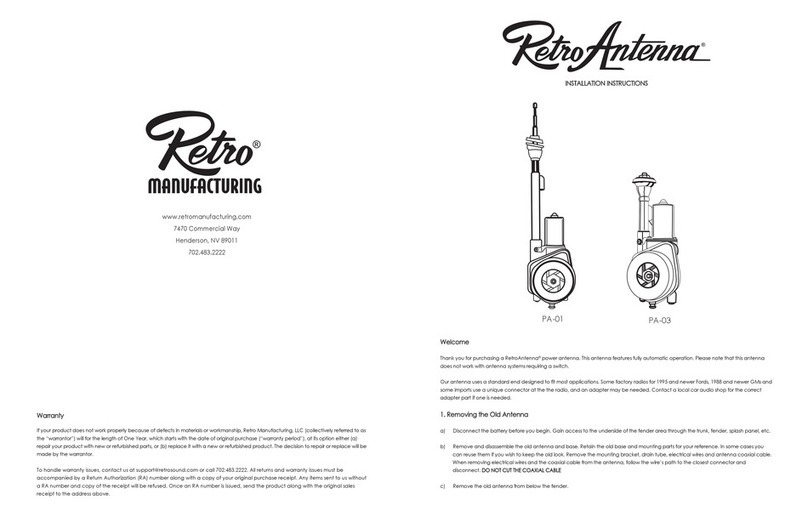
Retro Antenna
Retro Antenna PA-01 installation instructions

Feig Electronic
Feig Electronic ID ISC.ANT600-DA Application note
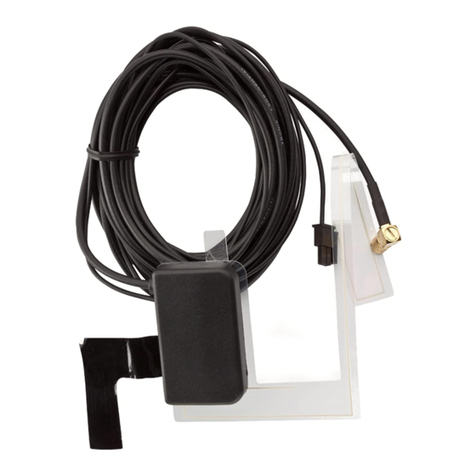
Dension
Dension DAB1ANT Installation and user manual
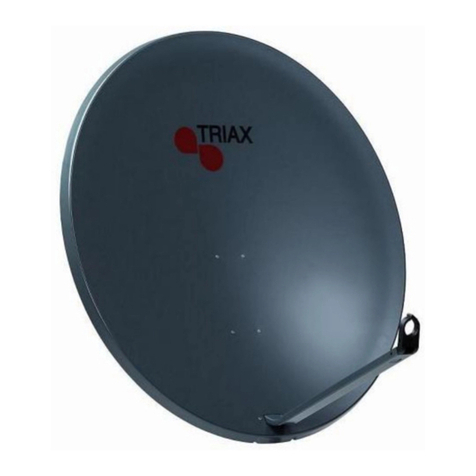
Triax
Triax TD110 dish Assembly and mounting instructions
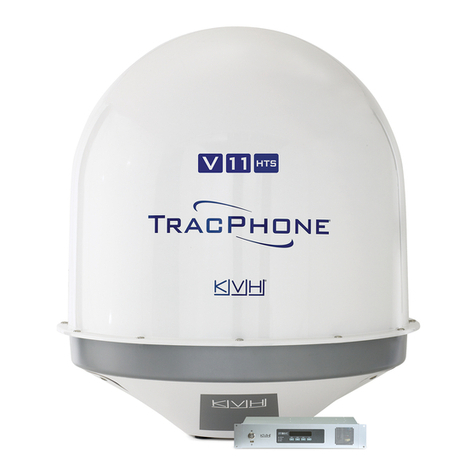
KVH Industries
KVH Industries TracPhone V11 hts installation guide
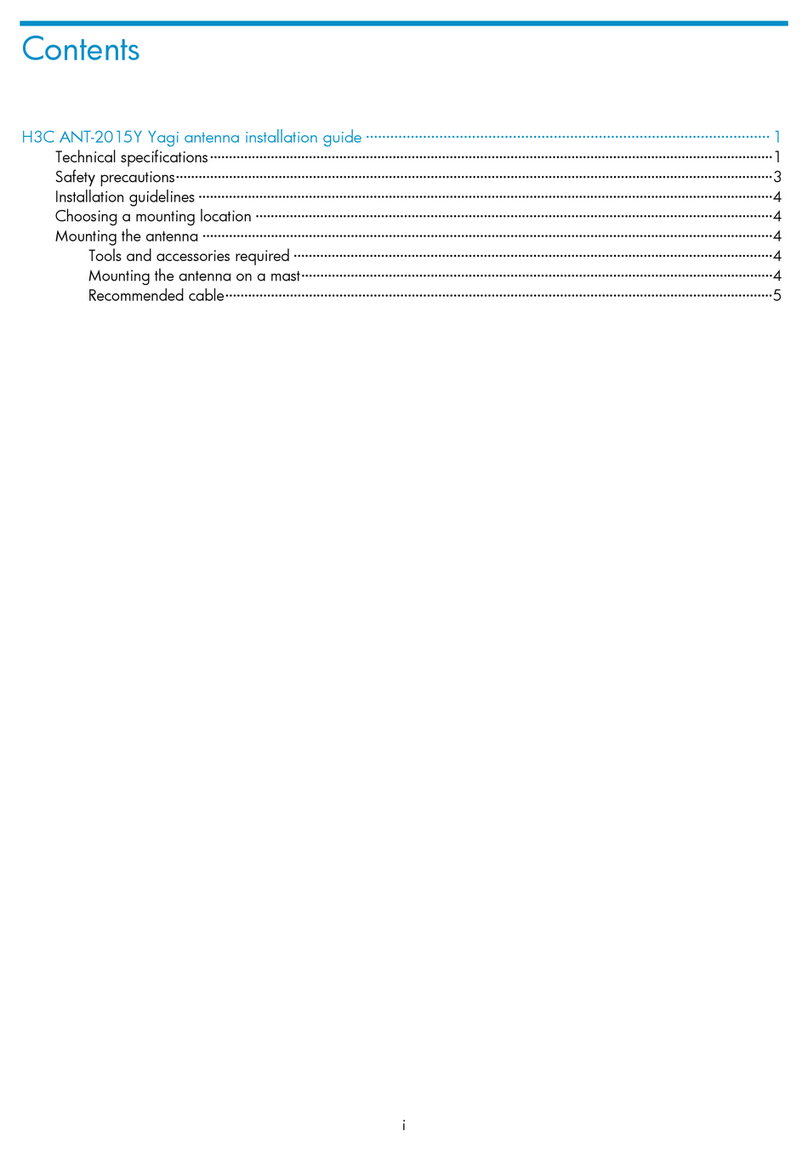
H3C
H3C ANT-2015Y manual
